Out of the ocean
Science fiction and Hollywood authors have provided increasingly sophisticated jump-so-much-you-drop-your-popcorn monsters, mutants, and aliens over the years, some of which you might have seen haunting the streets this past weekend. Even the fanciest CGI though can’t quite match mother nature’s own bizarre creations. Here’s my shortlist of the creepy-crawliest ocean inhabitants. The most likely to make it out of the ocean and into your candy-induced nightmares if you will.
Eunice aphroditois, The Bobbit Worm
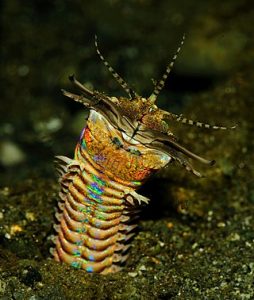
A bobbit worm burrowed into the sediment.
Source: Wikimedia Commons
Imagine you’re a fish swimming calmly along the ocean floor, you stop for a second, waving your fins around to stay put, inadvertently you brush up against an antenna-like thing behind you, then black. You’re struggling to swim up through sediment, being pulled quickly underneath, your fins increasingly tired and nearly paralyzed from toxin. You brushed up against a bobbit worm. That was a deadly mistake.
The bobbit worm lives in tropical waters across the globe, where it burrows deep into the sand and sediment. It is also referred to as the sand snatcher. It emerges from the sediment to feed with its strong pincer-like jaws. It quickly catches anything that comes close enough and pulls it under the sand where it can digest in peace. Bobbit worms are around 3-4 feet long on average, but one of the longest specimens was found in Japan in 2009, where the worm was living inside a float used for a fishing mooring raft. It was over 9 feet long!
Bobbit worms are polychaetes, a very diverse group of worms that have chaetes (bristle-like appendages) along the side of their bodies. You can see the bobbit’s chaetes along its edges in the picture. A fascinating feature of many annelid worms, like the bobbit, is their extracellular hemoglobin. Hemoglobin is molecule in your blood that binds and transports oxygen. In most organisms that molecule lives inside a cell, such as a red-blood cell, but annelids’ version of hemoglobin is wild and free.
Bobbit worms earn their nightmare-worthiness for their fast and stealthy ambush attacks and strong piercing jaws. Watch a video here. If you’re curious why they are called bobbit worms, it is after Lorena Bobbit, whom I suggest you google for another nightmare worthy story.
Phronima, The Pram Bug
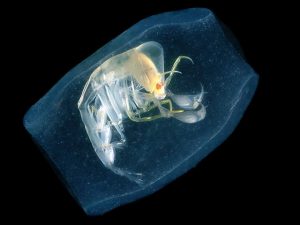
Phronima sp. inside a salp.
Photo credit: H. Bahena
This one actually is almost out of Hollywood. The ~1-2 inch amphipod is said to have been a source of inspiration for the monster from the iconic movie Alien (though the creator later denied this rumor). In any case, the pram bug is quite terrifying in its own right as it takes over the bodies of salps, pacifist gelatinous creatures that drift around the ocean feeding on small particles and plankton that they filter from the water. The pram bug will consume the salp’s inner organs and take over its gelatinous barrel to use as its own private little ocean spaceship and incubator. The female Phronima use the salp’s barrel to lay eggs and hatch young.
See these cool videos of them swimming around freely as well as coming in and out of salp barrels. Their parasitic tendencies and creepy if pint-sized features make them quite Halloween friendly.
Mitsukurina owstoni, The Goblin Shark
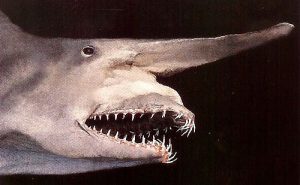
A goblin shark. Source: flickr.com
The goblin shark is plain weird-looking in my opinion. There’s not much known about this ocean dweller as it lives in deep waters and is rarely sighted. Its most striking feature is an unattached jaw that can extend outwards to capture prey. The movement is called slingshot feeding, as the upper jaw goes forward and the lower jaw makes a fast sweeping motion to meet it. You can read all about its slingshot feeding techniques here. And if you want extra jitters on this windy morning, watch a video here. Its claw-like teeth, truly goblin appearance, and large size (some specimens are 9 feet long) could give Jaws a run for its money.
Chironex fleckeri, Box Jelly
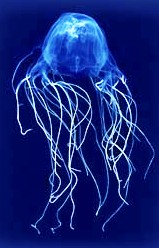
Chironex fleckeri, one of the deadly box jellies.
Source: Wikimedia commons.
You probably figured this one was coming. There are actually over 30 species of box jellies; they’re in the class Cubozoa. The one pictured here is Chironex fleckeri, sometimes called the sea wasp. It’s native to waters near Australia, Papau New Guinea, and the Philippines. Tentacles extend up to 10 feet in length when jellies are actively feeding but contract to a few inches otherwise. Box jellies have 24 small eyes along the edge of their bell that they can use to follow prey. Its poison, can induce cardiac arrest within several minutes. The venom is a porin, so named because they cause small pores to appear in exposed cells, disrupting the balance of ions across cell membranes crucial in cardiac tissues. I think jellies are quite beautiful in general, and will sometimes venture rather close to the non-deadly but still stinging ones, but in this case I rather keep my distance and prevent any unwanted stings or keep it from following me.
Osedax, Bone-Eating Worms
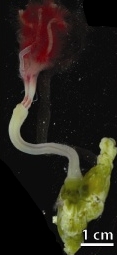
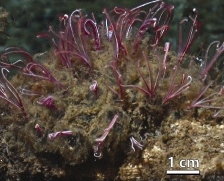
Close up of Osedax (left) and swarm (right). Source: Wikimedia commons.
So, I might have cheated a bit here. These critters aren’t actually scary they just sound like they should be. They’re a fairly recent addition to our knowledge of the ocean’s critters, with the first two species described in 2004. Osedax feed on bones and are often found in whale falls (where a dead whale sinks and decomposes). By recycling the organic material in bones they fill a unique and important niche in the marine nutrient cycle.
Since we all love the ocean and many of us spend a good amount of time there I’m going to cut this list off at 5 to avoid too many sleep-deprived JP students walking around lab this week. Especially since sleep deprivation and halloween candy binging are bound to create a frightening combination of uncoordinated movements ill-suited for lab work. If you have a favorite scary ocean creature that you think should have been on here though, email us and we’ll add it!